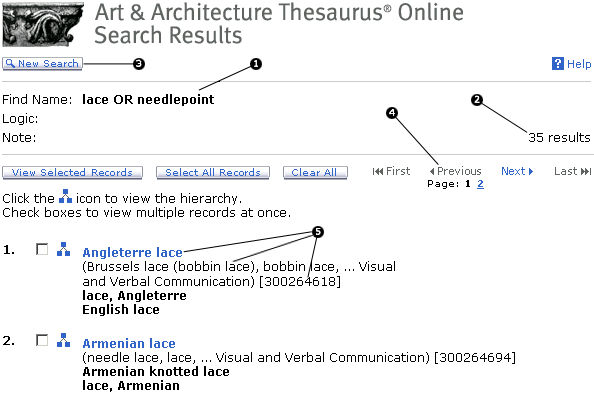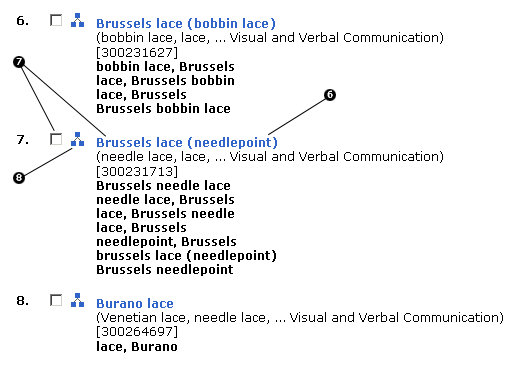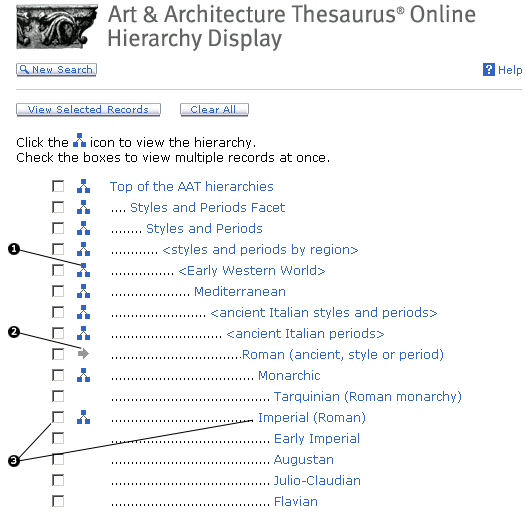 |
How to Use the Search Screen
- A term is a word or phrase that refers to a concept. You may search for terms related to art, architecture, and related disciplines, including types of objects and architecture (e.g., amphora, cathedral), materials (bronze, stained glass), styles and periods (e.g., Neolithic, Baroque), types of people (e.g., painters, sculptors), activities (e.g., museology, printmaking), physical attributes (e.g., inlays, crazing), and associated concepts (e.g., verism, sprezzatura). The AAT is not comprehensive. It grows over time through contributions.
Queries Using Find Term
- To find terms in the AAT, type one or more words in the Find Term field, using the guidelines described below. To learn more about what kinds of terms are included in the AAT, see About the AAT: Information in the Record (Fields).
- Case and punctuation: Terms may be entered in upper or lower case, with or without spaces and punctuation.
 |
|
|
 |
Examples: |
|
| |
Find Term: |
Pre-Columbian |
| |
Find Term: |
PRE COLUMBIAN |
| |
Find Term: |
precolumbian |
 |
|
- Diacritics: Terms may be entered with or without diacritics
(in the example below, querying with the cedilla will retrieve
the same results as typing the "c" without the cedilla).
 |
|
|
 |
Examples: |
|
| |
Find Term: |
façade |
| |
Find Term: |
facade |
 |
|
- Qualifier: Do NOT include the qualifier in the Find Term field. The qualifier is the word or phrase that appears to the right of the term, in parentheses in displays (e.g., screens (furniture)).
 |
|
|
 |
Examples: |
|
| |
Find Term: |
screens |
| |
Find Term: |
screens (furniture) [NOT this; including the qualifier will retrieve zero results]
|
| |
Find Term: |
precolumbian |
 |
|
- Boolean operators: You may use AND or OR in the Find Term field. These Boolean operators must be in ALL CAPS.
 |
|
|
 |
Examples: |
|
 |
Find Term: |
amphorae AND neck |
 |
Find Term: |
beehive domes OR calottes |
 |
|
- Parentheses: You may use parentheses with AND and OR. When using both AND and OR in the same query, parentheses should be used in order to retrieve meaningful results.
 |
|
|
 |
Examples: |
|
 |
Find Term: |
(flashed OR stained) AND glass |
 |
Find Term: |
(Venise OR Venetian) AND (lace OR point) |
 |
|
- Wildcard: You may use the asterisk (*) as a wildcard for right-hand truncation. You may also use a wildcard in the middle of the term. Left-hand truncation (leading truncation) is not allowed. You may use AND or OR with wildcards. Truncation of words with only a few letters (e.g., al*) will generally produce too many results and you will be prompted to narrow your search.
 |
|
|
 |
Examples: |
|
 |
Find Term: |
crux ansat* |
 |
Find Term: |
He*adic |
 |
Find Term: |
Oseb* OR Ringerik* |
 |
|
- Quotes: You may use quotes to find an exact match on your phrase. When you do not use quotes, the search engine looks for individual keywords that match your query. Using quotes is a good way to limit your search when the term is also a keyword in several multiple-word terms (e.g., the example below will retrieve the single record called simply "window," not terms with other keywords, such as "bay window" or "basement window").
 |
|
|
 |
Example: |
|
 |
Find Term: |
"window" |
 |
|
- Quotes with Booleans: You may use quoted phrases with OR; however, you may not use quoted phrases in parentheses. Note that quoted phrases would produce zero results with AND because such a query would be illogical. You may combine quoted and unquoted phrases.
 |
|
|
 |
Examples: |
|
 |
Find Term: |
"watercolor" OR "distemper" |
 |
Find Term: |
harquebus armor OR "armor" |
 |
|
- Stemming: Stemming may be enabled by placing a dollar sign ($) in front of the keyword that you wish to retrieve. Stemming allows queries for the word and its morphological variants. For example, $press would retrieve all terms that contain the word press or its grammatical variants in English: pressed, pressing, presses. Stemming is a feature designed to work best with English words. You may use stemming with AND and OR. You may use stemming with parentheses. Stemming would produce zero results when used with quotes because such a query would be illogical. Stemming of common words in terms will probably produce too many results and you will be prompted to narrow your search.
 |
|
|
 |
Examples: |
|
 |
Find Term: |
$press |
 |
Find Term: |
$print AND (block OR line) |
 |
|
Queries Using Note:
- When using Find Term, you may also query for a word or words in the Note field (Scope Note). To learn more about notes in the AAT, see About the AAT: Information in the Record (Fields). You many indicate AND or OR between the Find Term and the Note fields.
- You may use AND or OR in the Note search field itself; you may also use wildcards or stemming in the Note search field. Quotes may not be used in queries in the Notes field; if a user includes quotes in the Note field, the quotes will be ignored in the query.
Searching Tips
- If you are unsure of the spelling of a term, you may use the wildcard (e.g. amphor*). Only right and middle truncation are supported; left truncation is not allowed.
- If you fail to retrieve the record you are looking for, try looking for a single keyword, or two keywords with Boolean operators. For example, if a search for Romanesque basilica returns zero results, try looking for Romanesque OR basilica. This method is particularly useful for compound concepts; the AAT records single concepts (Romanesque basilica comprises two concepts, the style (Romanesque) and the form of the structure (basilica)).
- If the term you seek has a character with a diacritical mark and your search was unsuccessful, try typing the character without the diacritic.
- If you have searched for a term in inverted order and your search was unsuccessful, try searching for the term in natural order (e.g., search for onion dome rather than dome, onion).
- There is no stop list in The AAT Online. For example, since the words and and the are not on a stop list, you may search for terms such as bead and reel moldings and sculpture in the round.
- If you wish to use Boolean operators, you must capitalize the AND or OR.
- There is a limit of 5000 results. If you retrieve too many records, narrow your search by including more letters of the term or a second keyword of the term.
- When you cannot find a record by querying, try browsing through the hierarchy. Either click Browse the AAT Hierarchies below the search box, or search for a broader context. For example, if you are looking for a medieval style name, you may search for Medieval AND styles, in the Search Results click on the hierarchy for <Medieval styles and periods>, and browse through the records in this section of the hierarchy.
How to Read the Search Results

 |
 |
|
 |
 |
At the upper left of the Search Results, you will see the criteria that were used to retrieve the results (e.g., in the example above, Find Term was lace OR needlepoint). |
 |
 |
|
 |
 |
At the upper right, you will see the total number of results (35 results in the example above). |
 |
 |
|
 |
 |
You may return to the search screen by clicking New Search. |
 |
 |
|
 |
 |
Use the scroll bar along the right side to see results further down the page. Near the upper right of the page, you will see an indication of the number of pages of results (two pages in the example above) and navigation indicators to go forward or backward through the pages. In the example above, you could click on the number 2 or click Next to go to page two. You could click on First or Last to go to the beginning or end of the set of pages, which is useful when many pages are returned. |
 |
 |
|
 |
 |
The results are arranged in alphabetical order. Each concept is represented in the results list by its preferred term (descriptor). The preferred term is highlighted (in blue). On the line below the term is the parent string for the concept, listing broader contexts in ascending order (an ellipsis indicates that some levels have been omitted in the display). The number in square brackets is the unique numeric identifier (Subject ID) for the concept in the AAT database. All terms that matched the query are in the results list. If a term that matched the query is not the preferred term, it will be listed under the parent string, in black letters. For example, in result number 1 above, the preferred term for the concept is Angleterre lace, and a variant term, English lace, also matched the query (because it contains the keyword lace) and is displayed in black. |
 |
 |
|
 |
 |
 |
|
 |
 |
If the preferred term is a homograph, a qualifier will appear in parentheses to distinguish one concept from another. |
 |
 |
|
 |
 |
You may view the Full Record Display for any of the results by clicking on the highlighted (blue) preferred term. You may view multiple records at once by checking the boxes at the left and clicking View Checked Records at the top of the screen. You may clear checks from the boxes by clicking Clear All at the top of the screen. |
 |
 |
|
 |
 |
You may go to the hierarchy for any of the records in the results list by clicking on the hierarchy icon to the left of the term. |
 |
 |
|
How to Read the Full Record Display
- To go to a full record for an AAT concept, you must be in a results list or the hierarchical display. From either display, select the concept by 1) clicking on the highlighted (blue) term or 2) checking the checkboxes (to the left of the terms) for one or more concepts and then clicking View Checked Records.
- Brief descriptions of information in an AAT record appear below. A minimum record has a Term, Subject ID, Record Type, and Hierarchical Position. For a more complete explanation of the data in an AAT record, see About the AAT: Information in the Record (Fields).
- Subject ID: Unique numeric identification for the AAT record.
- Record Type: Type designation that characterizes the AAT record (concept, guide term, etc.); you may click on the highlighted word(s) to see the definition of the terminology.
- Label: Brief text identification of the concept, comprising the preferred term (descriptor), qualifier (if applicable), and abbreviated parent string (in parentheses). Click on the hierarchy icon to go to the hierarchy.
- Note: Often called the Scope Note, a note that describes what the term means in the context of the AAT.
- Terms: Words or phrases referring to the concept, including a preferred term and variant terms. Terms are displayed with various flags (e.g., "C,U,D" in the example below; click on the flag to see its meaning). The languages for the terms may also be included. A "P" following the language indicates that this is the preferred term in that language.
- Display Date for the term: A note referring to a date or other information about the term.
- Facet or Hierarchy Code: A special thesaurus code required by some catalogers who use the AAT.
- Hierarchical position(s): A display that shows broader contexts or parents of the concept. If there are multiple parents, the preferred parent is listed first.
- Display Date for the parent: A note referring to a date or other information about the link between a child and its parent, as in the example Early Imperial below. If a link is historical (rather than current), it is marked with an (H).
- Related Concepts: Associative relationships (i.e., non-hierarchical references) to other concepts in the AAT; each reference comprises a relationship type (e.g., generic related to or more specific, such as documents/products needed/produced) plus the preferred term, parent string, and subject ID for the related concept. The example below illustrates a related concept for broderie anglaise. Click on the highlighted (blue) term to go to the record of the related concept.
- Display Date for the related concept: A note referring to a date or other information about the relationship between the two concepts. The example below includes a display date for the related concept cup-hilts in the record for rapiers.
- Sources and Contributors: Initials, abbreviations, or acronyms for the contributing projects or institutions (in square brackets), combined with bibliographic sources. Sources and Contributors may be associated with the record in three ways: with the terms, with the record as a whole (subject), and with the note (scope note). Click on the initials of the contributor or the brief citation of the source to see a fuller description of the contributor or source.
How to Navigate the Hierarchy Display
- You may go to the Hierarchy Display by clicking on the hierarchy icon in a results list or in a full record display. You may also access it by clicking on Browse the AAT Hierarchies from the search screen.

|
 |



